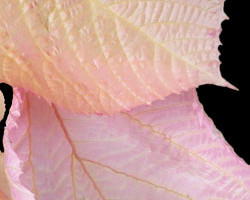
- by Ed
- 0
- Posted on
Flowerfashion: Alchornea davidii
Alchornea davidii surprises with salmon pink leaves

Alchornea davidii, a new plant, is introduced in Europe. This stunning shrub or small tree is likely to have a promising future.
Alchornea davidii Leaves
In springtime Alchornea davidii (synonym: Alchornea trewioides) is a really stunning plant in your garden. In May it sprouts with a flush of leaves you will certainly remember: young leaves are bright salmon pink to soft flamingo pink! Looking from beneath the leaves look a little bit translucent.
Salmon pink is a highly desired colour in my garden. In the plant kingdom you don’t find this color very often. Just like vivid lemon green and fresh lemon yellow, which I also find very attractive. Because these hues are so rare and appealing, they always draws people’s attention.
On the internet you can find many pictures of Alchornea davidii with a flaming reddish pink colour in spring. The colour of the leaves is probably influenced by local conditions. I assume spring colour is soft pink in semi-shade, and a deeper reddish pink in full sun. Large temperature differences between day and night may also deepen leaf colour in springtime.
As the season progresses the leaves of Alchornea davidii turn green in summer. In autumn the leaves can get tints of yellow and red, depending on wheather conditions.
Alchornea davidii Flowers
Flowers of Alchornea davidii are not very showy. Red flower buds appear shortly after sprouting of the leaves. Flower buds are small and grow in clusters at leaf axils along the branches. After opening each flower bud shows an insignificant flower. Petals are absent; stamens and styles are red.
Applications of Alchornea davidii
Alchornea davidii is suited for gardens, estates and parks. In your garden you can combine it with other woody plants or use it at the back in a border. The plant also stands out as a solitary shrub in the lawn.
In small gardens it is advisable to use a bamboo root barrier, made of a thick PE film. This will contain rampant root growth and prevents unwanted spread by underground root suckers.
I think in The Netherlands Alchornea davidii also stands out on roadside slopes along the highway, as a colourful alternative to Amelanchier lamarckii. It would make a drive along the highway a breathtaking experience!
Alchornea davidii & climbing Clematis
For gardens I think a climbing Clematis is a great companion plant for Alchornea davidii, because:
- Alchornea leaves offers spring interest.
- Clematis flowers offer summer interest.
IMHO Clematis is a plant that has special requirements. And Alchornea seems to match the demands of climbing Clematis perfectly:
- Alchornea branches provide support.
- Early in spring Clematis sprouts with vigorous shoots; these shoots need support to grow upwards. Alchornea forms sturdy upright branches that provide a solid support for Clematis. Long leaf petioles of Alchornea add additional support.
- Alchornea grows about 150-200 cm tall, which is a perfect height for most climbing Clematis.
- Clematis leaves start to unfold quite late, so they don’t distract from the pink Alchornea in spring.
- Branches of Alchornea hardly form side branches. This makes Clematis stems easy to remove during cleanup.
- Alchornea leaves turn green in summer.
Clematis flowers, in whatever colour, benefit from a green background of another plant. By the time Clematis starts to flower the large leaves of Alchornea have turned green, thus the Clematis flowers show off nicely against the green Alchornea.
Background Info Alchornea davidii
Alchornea davidii belongs to the family of Euphorbiaceae and grows naturally in Central and East China. Though it is native in the tropics and subtropics, experience shows it is winter hardy in The Netherlands.
Alchornea is a dioecious, deciduous shrub or small tree. In nature it can reach a height of 500 cm. In cultivation it probably remains somewhat smaller, 150-300 cm tall (depending on pruning).
Alchornea species have been used in traditional Chinese medicine for centuries. Research has shown the genus contains many bioactive compounds. Their secondary metabolites have anti-microbial, anti-fungal and anti-cancer activities.